Lexicon of Glitch Affect
Over the past decennia, the glitch art genre has grown up so much: glitch (and glitch art) is not just an aesthetic in digital art, glitch is in the world now.
The understanding of artifacts inherent to digital technologies, such as cracked screens, broken images, analog noise… All these artifacts have become normalised: digital technologies have become ubiquitous and so have these artifacts. They are everywhere. Everywhere is now littered with glitch.
Glitches are on the flyer of my local falafel shop in Berlin. They are in the commercials of my least favorite politicians. I can even deploy them as a face filter on instagram! As a result, glitches are far from the scary, unexpected break they once were.
Today, the glitch effect is either used purely for its aesthetics, or as a reference to its technological cause. This is why the glitch has evolved from meaningless break of a flow, to an effect with a signifying quality: over the past decades, the glitch has become a figure of speech. And this is what I researched in this “Lexicon of Glitch Affect”.
The Lexicon intends to offer an insight into the development of meaning in the aesthetics of distortion in Sci-Fi movies throughout the years, via an analysis of 1200 Sci-Fi Trailers. Starting with trailers from 1998, I reviewed 30 trailers per year to obtain an insight into the development of noise artifacts in Sci-Fi from before the normalization of the home computer, to Sci-Fi adopting the contemporary aesthetics of our ubiquitous digital devices. My source for the trailers is the Internet Movie Database, where I accessed lists of the top-US Grossing Sci-Fi Titles per year. When watching these trailers I took screenshots whenever a distortion occured. Then, if possible, I would interpret them. Currently the database includes findings from research done into 630 trailers (1998-2018) but I wish to extend it to 1980-2020, spanning the 40 years of advancements in digital technologies and its distortions.
Underneath this very short essay I offer my most interesting findings per year.
When you click an image, you get access to the noise artifacts per year.
Glitch Art genre (2019) Every file format consists of a language, or ‘dialect’, according to which it is encoded, often also refered to as a compression algorithm. When we break this organization of data, by for instance glitching or databending, a new utterance or visual expression appears, showcasing the otherwise obfuscated organizations of compression on the surface of the image. These newly emerged images are often directly dismissed as 'garbage' or 'noise artifacts’, but sometimes, the results of these noise artifacts can in fact reveal exciting, unexpected new forms of expression or ‘visual slang’. It is these modes of expression that artists have named the genre of Glitch Art. But, to call glitch a genre suggests it is intelligible and that it follows certain norms or rules.
From its beginnings, glitch art used to exploit medium-reflexivity, to rhetorically question technologies ‘perfect’ use, conventions and expectations. However, paradoxically, over time glitch art has become standardized into a genre that also fulfills certain expectations (oa. to rhetorically question the medium). This reflexive approach inherent in the materiality of the glitch tends to, as Katherine Hayles would assert, re-conceptualize the glitches’ materiality into an interplay between its ‘physical characteristics and its signifying strategies’. But glitch genres perform their reflection on digital materiality not just on a technological level. To really understand a glitch, each level of this notion of (glitch) materiality should be studied: the text as a physical artifact, its conceptual content, and the interpretive activities of artists and audiences.
Distortions in Sci-Fi
Distortions prompt the spectator to engage not only with themes, but also with complex subcultural and meta-cultural narratives and gestures, presenting new analytical challenges. In the Glitch Moment(um) (Institute of Network Cultures, 2010) I wrote that every form of glitch, either breaking a flow, or designed to look like a break from a flow, will eventually become a new fashion. As the popularization and cultivation of the glitch genre has now spread widely, I believe it is important to track the development of these processes in specific case studies and create ‘a lexicon of distortions’. New, fresh research within the field of noise artifacts is necessary. In an attempt to expand on A Vernacular of File Formats, I propose a lexicon that deconstructs the meanings of noise artifacts; a handbook to navigate glitch clichés as employed specifically in the genre of Sci-Fi.
Sci-Fi relies on the literacy of the spectator (references to media technology texts, aesthetics and machinic processes) and their knowledge of more ‘conventional’ distortion or noise artifacts. Former disturbances have gained complex meaning beyond their technological value; with the help of popular culture, these effects have transformed into signifiers provoking affect. For example, analogue noise conjures up the sense of an eerie, invisible power entering the frame (a ghost), while blocky-artifacts often refer to time travelling or a data offense initiated by an Artificial Intelligence. Interlacing refers to an invisible camera, while camera interface esthetics (such as a viewfinders and tracking brackets or markers around a face) refer to observation technologies. Hackers still work in monochrome, green environments, while all holograms are made from phosphorous blue light. And when color channels distort, the protagonist is experiencing a loss of control.
︎Click on a year and see all the a/effect per trailer of that year!
The understanding of artifacts inherent to digital technologies, such as cracked screens, broken images, analog noise… All these artifacts have become normalised: digital technologies have become ubiquitous and so have these artifacts. They are everywhere. Everywhere is now littered with glitch.
Glitches are on the flyer of my local falafel shop in Berlin. They are in the commercials of my least favorite politicians. I can even deploy them as a face filter on instagram! As a result, glitches are far from the scary, unexpected break they once were.
Today, the glitch effect is either used purely for its aesthetics, or as a reference to its technological cause. This is why the glitch has evolved from meaningless break of a flow, to an effect with a signifying quality: over the past decades, the glitch has become a figure of speech. And this is what I researched in this “Lexicon of Glitch Affect”.
The Lexicon intends to offer an insight into the development of meaning in the aesthetics of distortion in Sci-Fi movies throughout the years, via an analysis of 1200 Sci-Fi Trailers. Starting with trailers from 1998, I reviewed 30 trailers per year to obtain an insight into the development of noise artifacts in Sci-Fi from before the normalization of the home computer, to Sci-Fi adopting the contemporary aesthetics of our ubiquitous digital devices. My source for the trailers is the Internet Movie Database, where I accessed lists of the top-US Grossing Sci-Fi Titles per year. When watching these trailers I took screenshots whenever a distortion occured. Then, if possible, I would interpret them. Currently the database includes findings from research done into 630 trailers (1998-2018) but I wish to extend it to 1980-2020, spanning the 40 years of advancements in digital technologies and its distortions.
Underneath this very short essay I offer my most interesting findings per year.
When you click an image, you get access to the noise artifacts per year.
Glitch Art genre (2019) Every file format consists of a language, or ‘dialect’, according to which it is encoded, often also refered to as a compression algorithm. When we break this organization of data, by for instance glitching or databending, a new utterance or visual expression appears, showcasing the otherwise obfuscated organizations of compression on the surface of the image. These newly emerged images are often directly dismissed as 'garbage' or 'noise artifacts’, but sometimes, the results of these noise artifacts can in fact reveal exciting, unexpected new forms of expression or ‘visual slang’. It is these modes of expression that artists have named the genre of Glitch Art. But, to call glitch a genre suggests it is intelligible and that it follows certain norms or rules.
From its beginnings, glitch art used to exploit medium-reflexivity, to rhetorically question technologies ‘perfect’ use, conventions and expectations. However, paradoxically, over time glitch art has become standardized into a genre that also fulfills certain expectations (oa. to rhetorically question the medium). This reflexive approach inherent in the materiality of the glitch tends to, as Katherine Hayles would assert, re-conceptualize the glitches’ materiality into an interplay between its ‘physical characteristics and its signifying strategies’. But glitch genres perform their reflection on digital materiality not just on a technological level. To really understand a glitch, each level of this notion of (glitch) materiality should be studied: the text as a physical artifact, its conceptual content, and the interpretive activities of artists and audiences.
Distortions in Sci-Fi
Distortions prompt the spectator to engage not only with themes, but also with complex subcultural and meta-cultural narratives and gestures, presenting new analytical challenges. In the Glitch Moment(um) (Institute of Network Cultures, 2010) I wrote that every form of glitch, either breaking a flow, or designed to look like a break from a flow, will eventually become a new fashion. As the popularization and cultivation of the glitch genre has now spread widely, I believe it is important to track the development of these processes in specific case studies and create ‘a lexicon of distortions’. New, fresh research within the field of noise artifacts is necessary. In an attempt to expand on A Vernacular of File Formats, I propose a lexicon that deconstructs the meanings of noise artifacts; a handbook to navigate glitch clichés as employed specifically in the genre of Sci-Fi.
Sci-Fi relies on the literacy of the spectator (references to media technology texts, aesthetics and machinic processes) and their knowledge of more ‘conventional’ distortion or noise artifacts. Former disturbances have gained complex meaning beyond their technological value; with the help of popular culture, these effects have transformed into signifiers provoking affect. For example, analogue noise conjures up the sense of an eerie, invisible power entering the frame (a ghost), while blocky-artifacts often refer to time travelling or a data offense initiated by an Artificial Intelligence. Interlacing refers to an invisible camera, while camera interface esthetics (such as a viewfinders and tracking brackets or markers around a face) refer to observation technologies. Hackers still work in monochrome, green environments, while all holograms are made from phosphorous blue light. And when color channels distort, the protagonist is experiencing a loss of control.
︎Click on a year and see all the a/effect per trailer of that year!
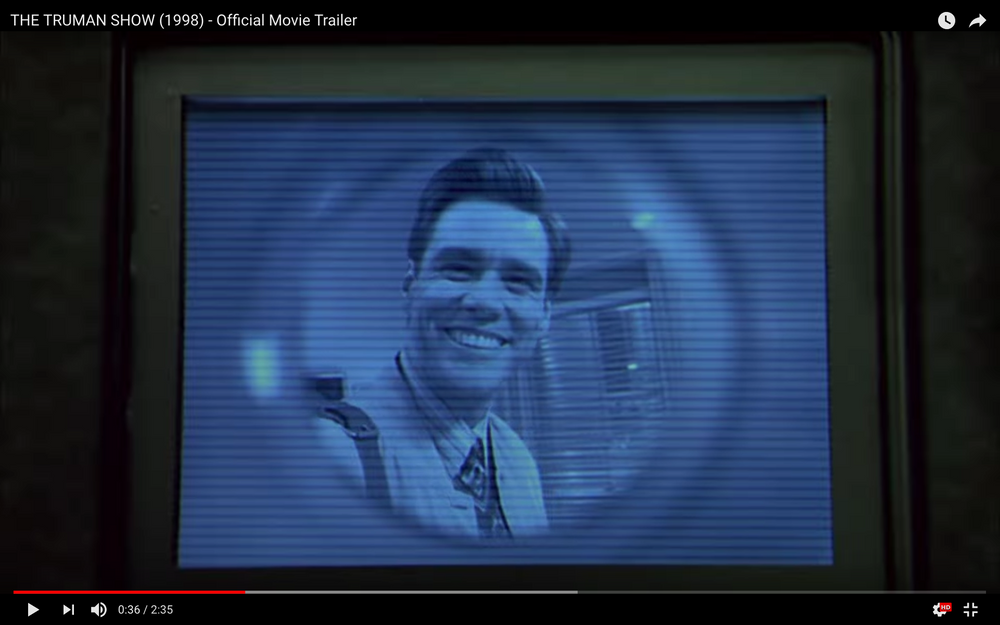 1998 - In the Truman Show, CCTVs secret observation cameras are outfitted with scanlines and vignetting.
1998 - In the Truman Show, CCTVs secret observation cameras are outfitted with scanlines and vignetting. 1999 - Unicode characters displayed as streams of monochrome, vertical data signify the hackers navigating ‘the Matrix’.
1999 - Unicode characters displayed as streams of monochrome, vertical data signify the hackers navigating ‘the Matrix’. 2000 - Sci fi screens feature a lot of blue because sets often use tungsten (warm) light. Filmmakers compensate for this in post processing, during which blue colors are effected the least, maintaining the vibrancy of other colors the best.
In this shot from Supernova, a critical SOS signal is received.
2000 - Sci fi screens feature a lot of blue because sets often use tungsten (warm) light. Filmmakers compensate for this in post processing, during which blue colors are effected the least, maintaining the vibrancy of other colors the best.
In this shot from Supernova, a critical SOS signal is received.
 2001 - in Jimmy Neutron, an alien observes the parents. A voice over says: “The crummy aliens stole our parents”
2001 - in Jimmy Neutron, an alien observes the parents. A voice over says: “The crummy aliens stole our parents”
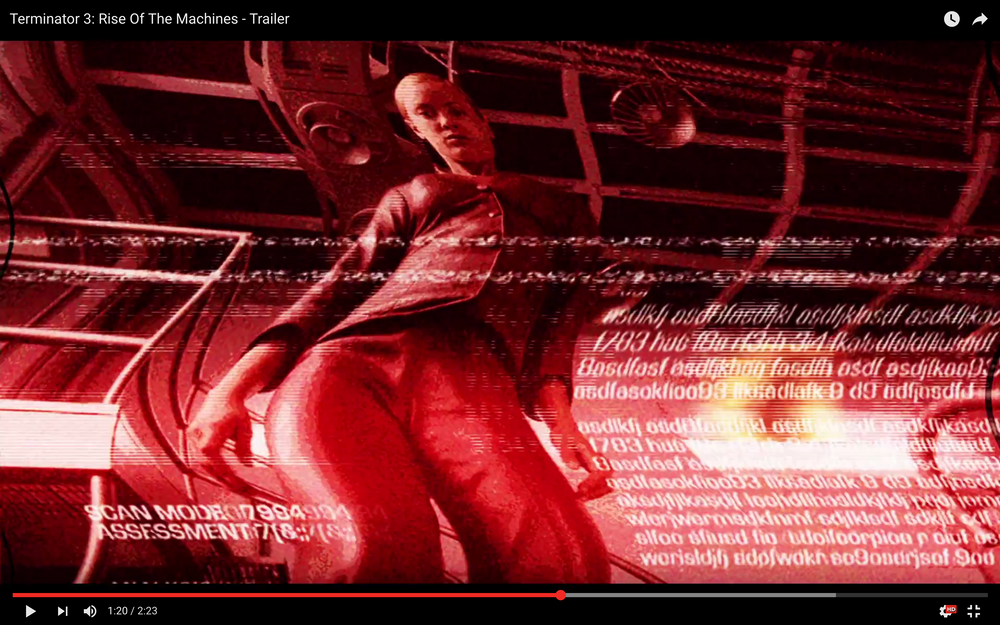 2003 - “The machines are starting to take over!” is uttered when T-X knocks out the terminator. A combination of what seems like digital and analogue, monochrome red distortions cover the ‘interface’ of the Terminators point of view as he goes down.
2003 - “The machines are starting to take over!” is uttered when T-X knocks out the terminator. A combination of what seems like digital and analogue, monochrome red distortions cover the ‘interface’ of the Terminators point of view as he goes down. 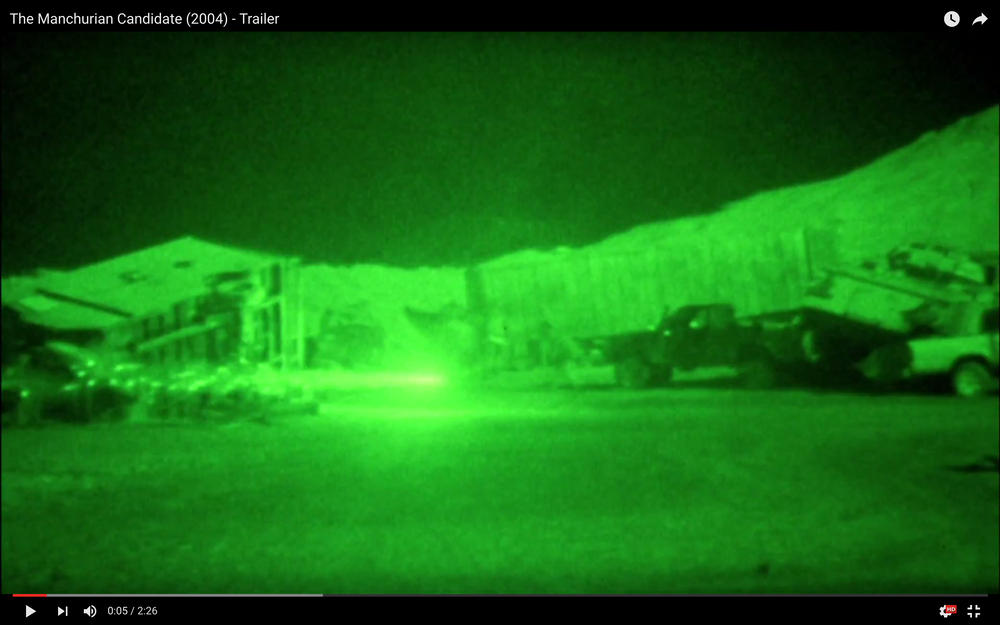 2004 - In The Manchurian Candidate, soldiers are kidnapped and brainwashed for sinister purposes. Some of the shots use military night vision equiplement.
2004 - In The Manchurian Candidate, soldiers are kidnapped and brainwashed for sinister purposes. Some of the shots use military night vision equiplement. 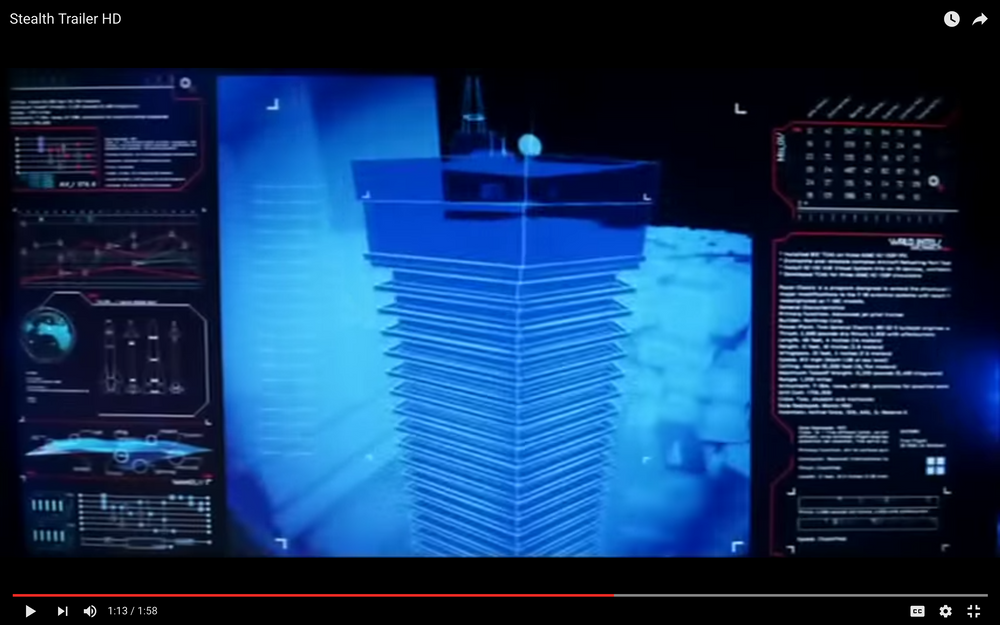 2005 - In Stealth, an artificial intelligence program has “rewired itself and chosen its own target”. Blue, phosphorous holograms are flanked by non understandable diagrams and information.
2005 - In Stealth, an artificial intelligence program has “rewired itself and chosen its own target”. Blue, phosphorous holograms are flanked by non understandable diagrams and information. 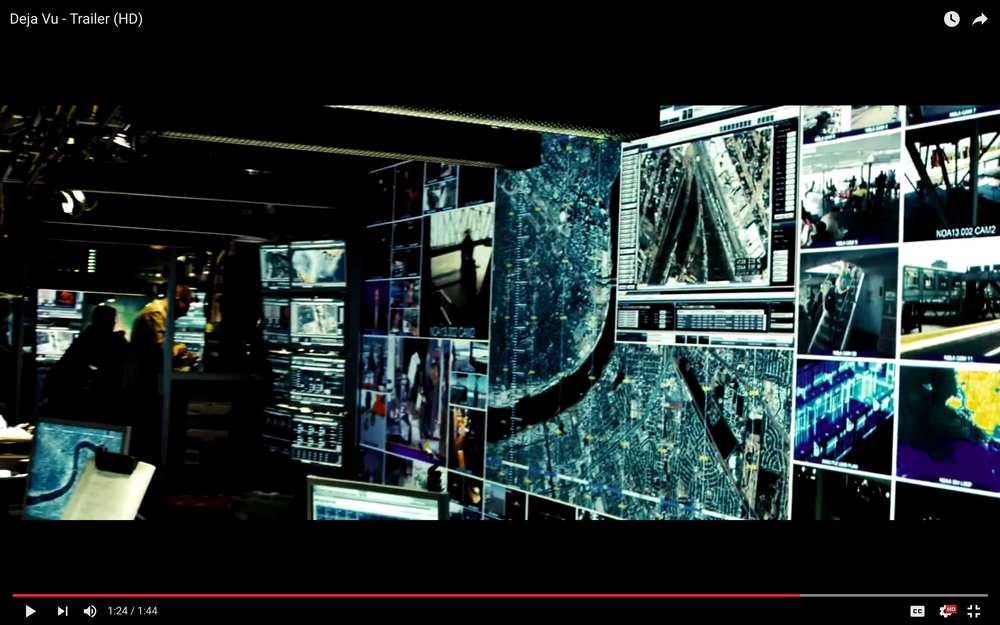 2006 -
‘experimental surveillance technology’ uses grid like, monochrome maps on top of maps in Deja Vu
2006 -
‘experimental surveillance technology’ uses grid like, monochrome maps on top of maps in Deja Vu 2007 - Umbrella Corp uses surveillance technology, which uses tracking brackets and facial markers to compare a target to an image file.
2007 - Umbrella Corp uses surveillance technology, which uses tracking brackets and facial markers to compare a target to an image file.
 2008 - Interruptions in live television streams are no longer illustrated by analogue noise, but by macroblocking artifacts (referencing new .mp4 and streaming technologies) in Quarantine.
2008 - Interruptions in live television streams are no longer illustrated by analogue noise, but by macroblocking artifacts (referencing new .mp4 and streaming technologies) in Quarantine. 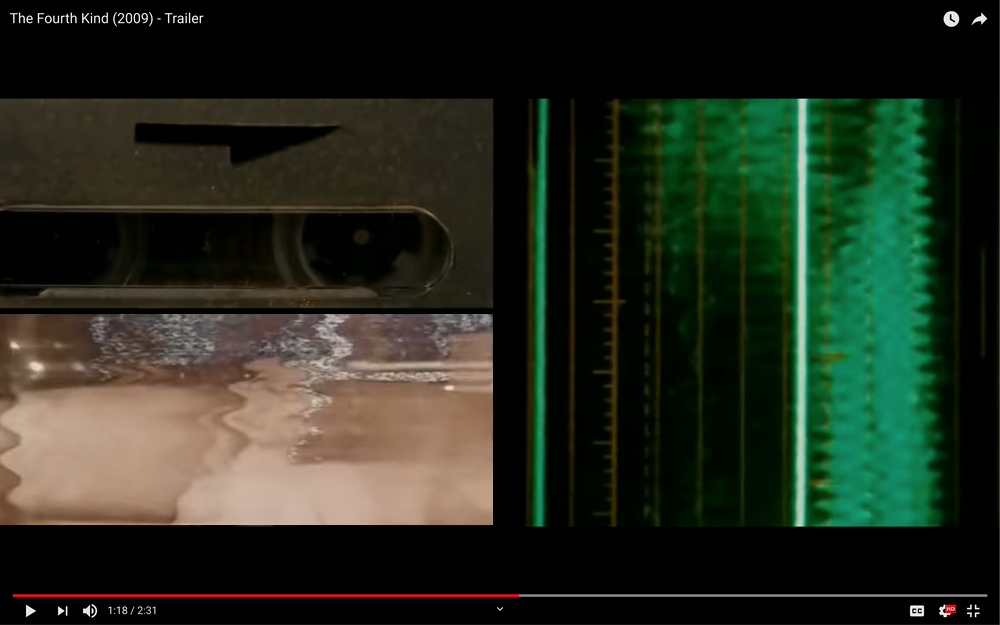 2009 - A fantastic year for glitch artifacts in sci fi, my favorite trailer is the Fourth Kind, which features monchrome EVP alongside analogue, wobbulating video registrations.
2009 - A fantastic year for glitch artifacts in sci fi, my favorite trailer is the Fourth Kind, which features monchrome EVP alongside analogue, wobbulating video registrations.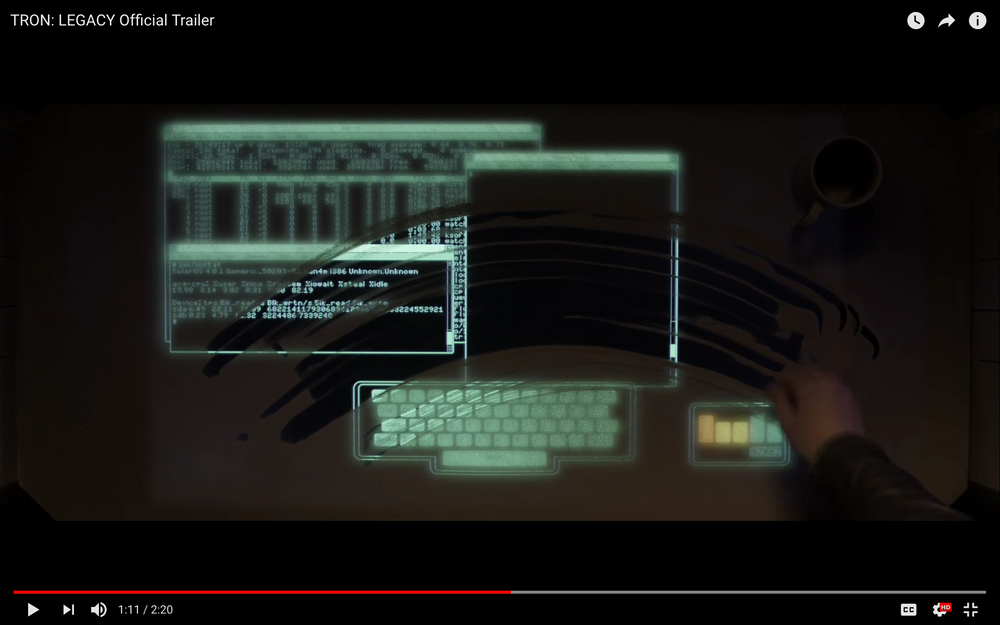 2010 - The good old text based, cyano green (old and hacker) console that functions as a portal to Tron.
2010 - The good old text based, cyano green (old and hacker) console that functions as a portal to Tron. 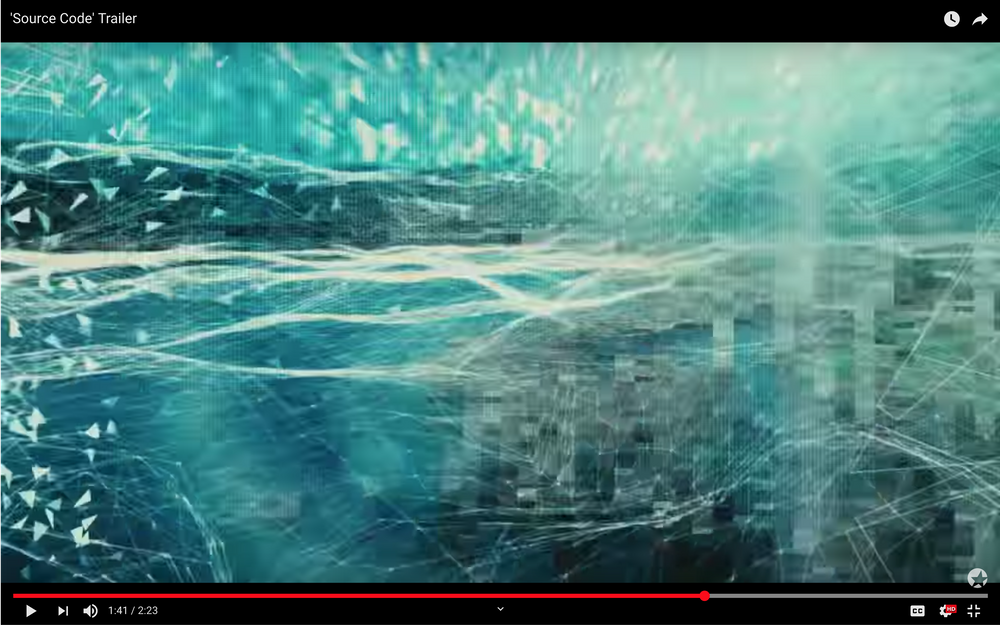 2011 - In Source code, a soldier can not only jump back in time but also into someone else's body. These jumps are always rough and confusing. Aesthetically, the jump look a body fell apart into little triangular vectors travelling a somewhat noisy, blocky [that must be the time shift] wire plane.
2011 - In Source code, a soldier can not only jump back in time but also into someone else's body. These jumps are always rough and confusing. Aesthetically, the jump look a body fell apart into little triangular vectors travelling a somewhat noisy, blocky [that must be the time shift] wire plane.
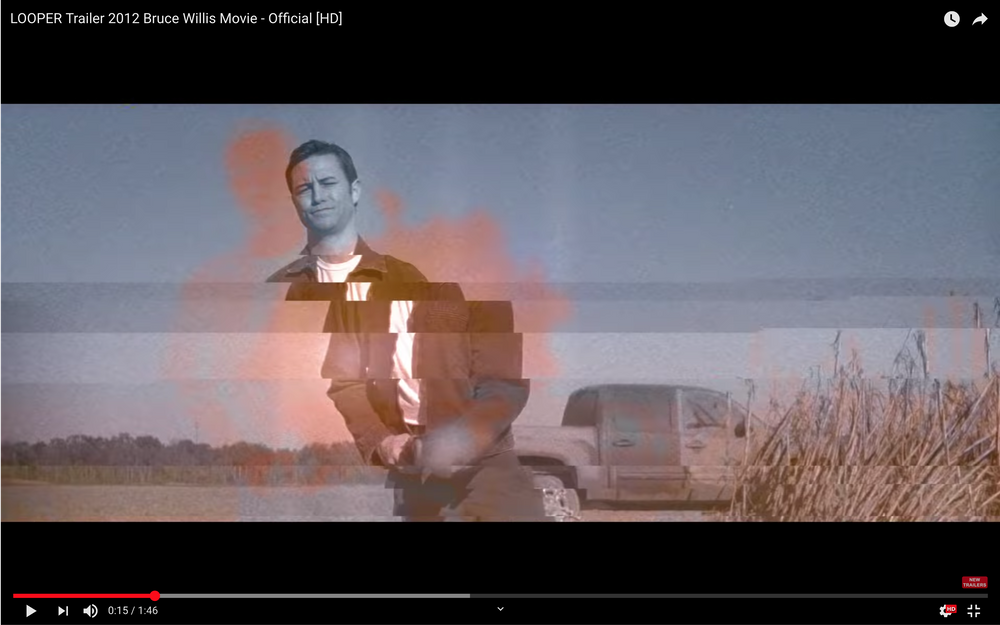 2012 - Looper is set in 2074. In this time, when the mob wants to get rid of someone, the target is sent into the past, where a hired gun awaits. Time jump problems are shown by a sliced image with ghosting colors.
2012 - Looper is set in 2074. In this time, when the mob wants to get rid of someone, the target is sent into the past, where a hired gun awaits. Time jump problems are shown by a sliced image with ghosting colors. 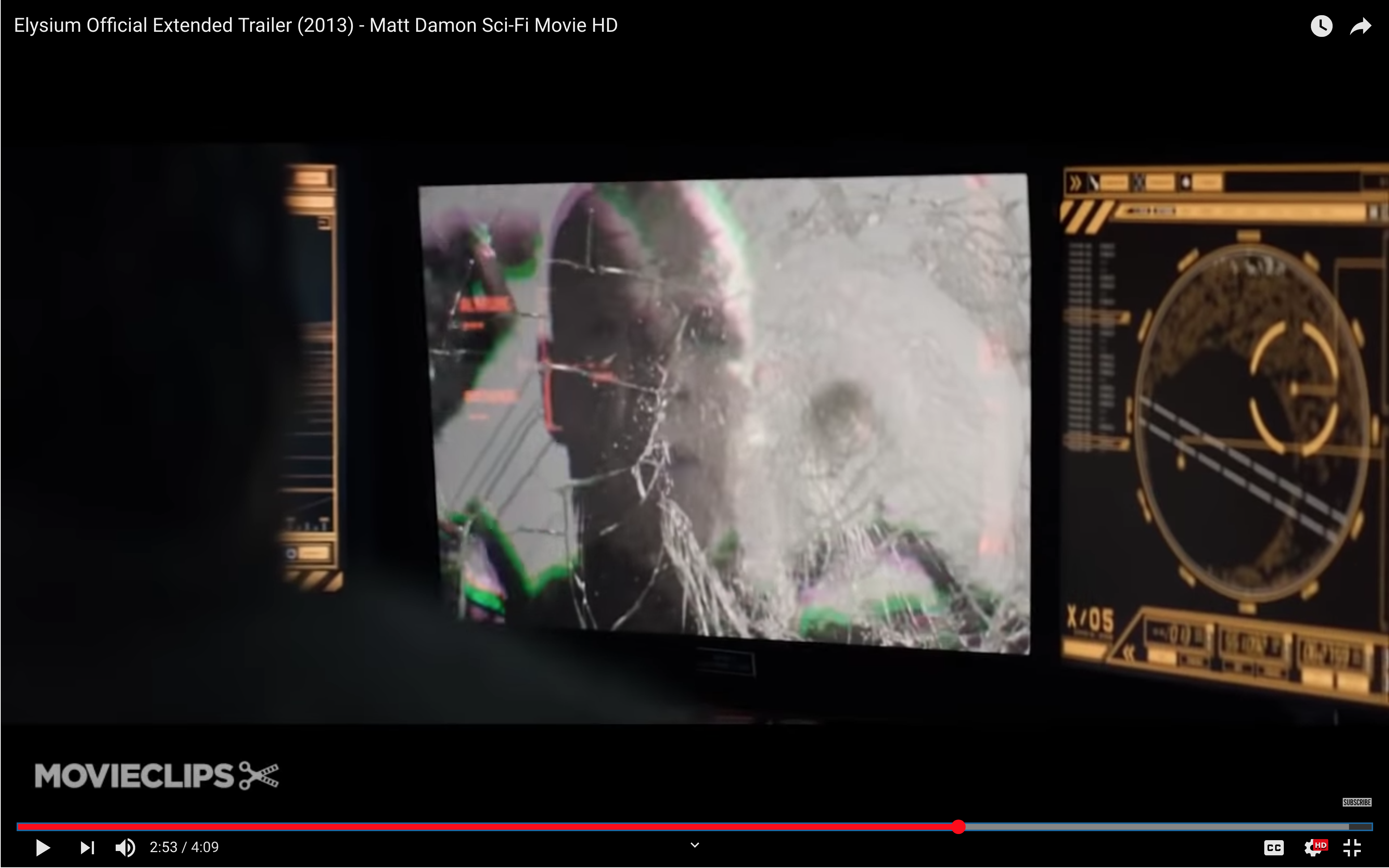 2013 - In Elysium, Max is observed through a broken monitor. It is so action packed, even the color channels are no longer properly aligned.
2013 - In Elysium, Max is observed through a broken monitor. It is so action packed, even the color channels are no longer properly aligned.  2014 - During a fighting scene between Electro, who has the ability to control electricity, and Spiderman, the billboards of Times Square go all glitchy. ÷ The Amazing Spider-Man™ 2 (2014) was shot on KODAK VISION3 Color Negative Film.
2014 - During a fighting scene between Electro, who has the ability to control electricity, and Spiderman, the billboards of Times Square go all glitchy. ÷ The Amazing Spider-Man™ 2 (2014) was shot on KODAK VISION3 Color Negative Film.
All the bill boards glitch and finally explode, while Kodak is the of the last billboards left standing.
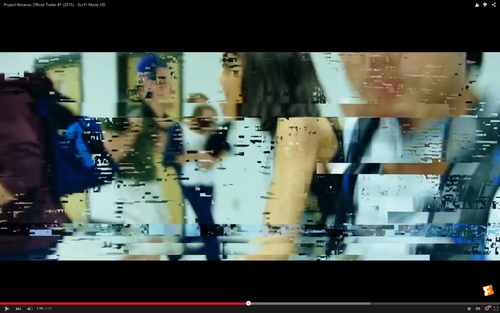 2015 - A group of teens discover secret plans of a time machine, and construct one. However, things start to get out of control. This is when blocking artifacts occur (similar to DV blocking when a tape is being FFWD).
2015 - A group of teens discover secret plans of a time machine, and construct one. However, things start to get out of control. This is when blocking artifacts occur (similar to DV blocking when a tape is being FFWD). 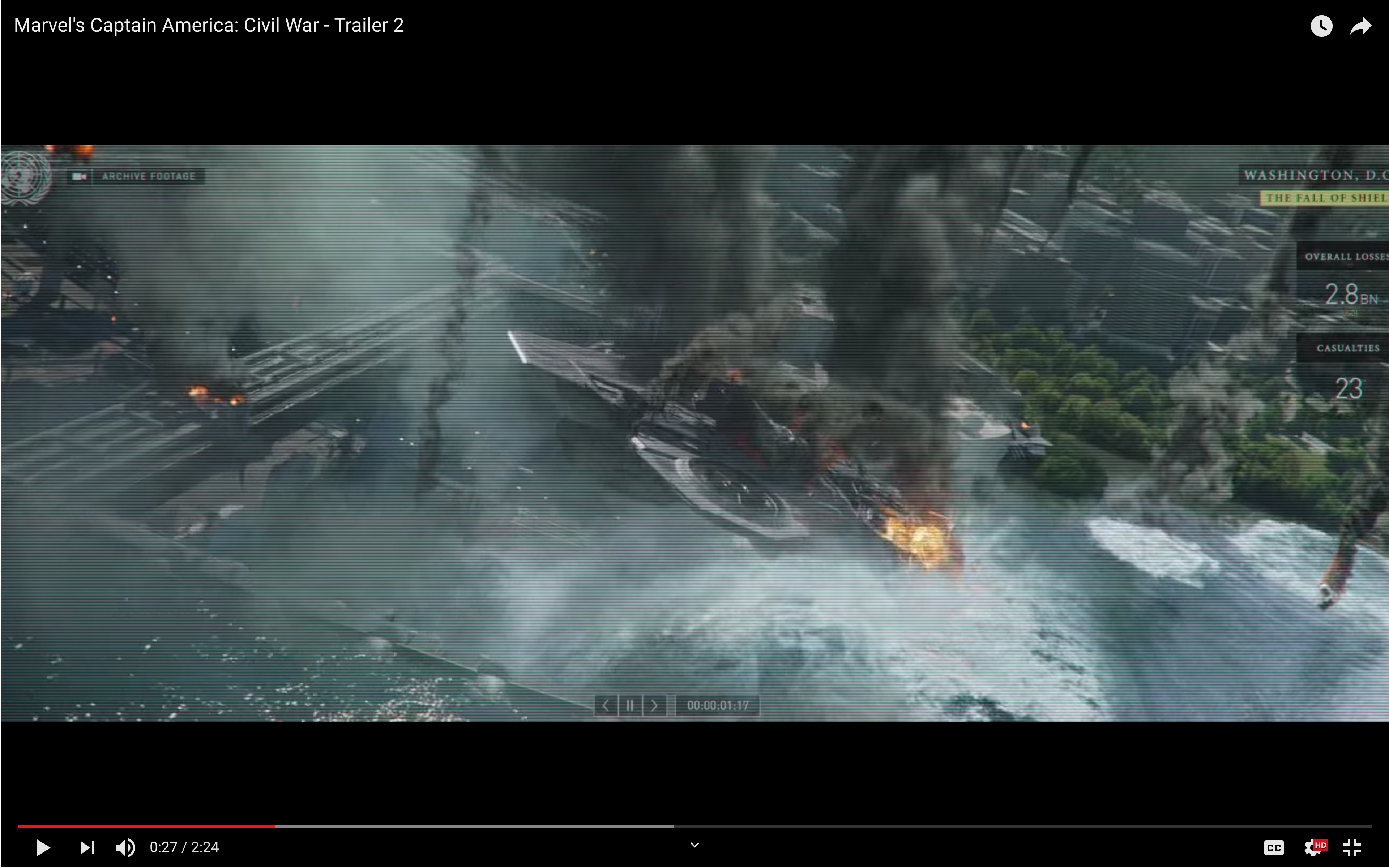 2016 - In Captain America, archival footage features very clean and clear (digital) scan lines.
2016 - In Captain America, archival footage features very clean and clear (digital) scan lines. 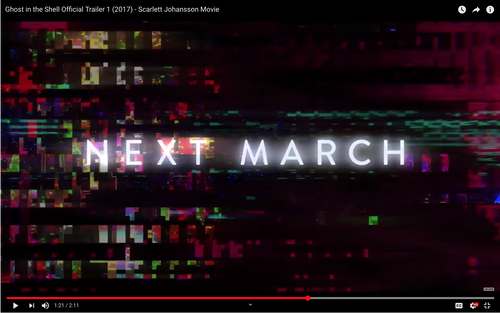 2017 was a very interesting year for noise artifacts. Several trailers use them very meaningfully. In the Ghost in the Shell, ‘noise’ is more complex than contemporary compression artifacts (combining color channels, blocks, lines and some structures that are not, as far as I can see, directly referencing any compression). This must signify the ghost, existing and developing as a very complex creature inside the networks.
2017 was a very interesting year for noise artifacts. Several trailers use them very meaningfully. In the Ghost in the Shell, ‘noise’ is more complex than contemporary compression artifacts (combining color channels, blocks, lines and some structures that are not, as far as I can see, directly referencing any compression). This must signify the ghost, existing and developing as a very complex creature inside the networks. 2018 - In Annihilation, a biologist is confronted with a mysterious zone where the laws of nature (and distortion) don't apply. Here destortions are not destroying something, but they are ‘making something new’.
2018 - In Annihilation, a biologist is confronted with a mysterious zone where the laws of nature (and distortion) don't apply. Here destortions are not destroying something, but they are ‘making something new’.
